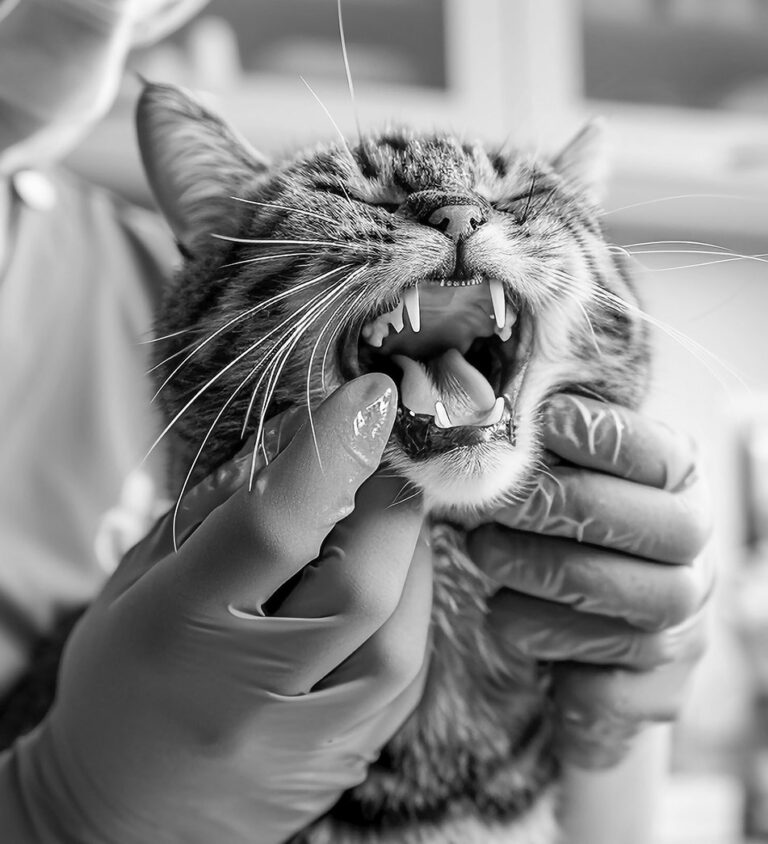
Feline Dental Care
Cats, like dogs and humans, commonly have oral disease.
You may not realize your cat has dental disease because feline dental disease often has symptoms that can be confused with other diseases which affect their health.
Symptoms of feline dental disease or signs of a painful mouth:
Bad Breath
If your cat has persistent bad breath, it can be a sign of dental issues such as gingivitis or periodontal disease.
Drooling
Excessive drooling or excessive saliva may indicate pain or infection in the mouth.
Pawing at the Mouth
Cats may paw at their mouth if they are experiencing discomfort or pain.
Difficulty Eating
If a cat is reluctant to eat, drops their food, chews on one side, flips their head side-to-side when chewing, drops their food AND walks away, or gulps their food to minimize chewing (which often triggers them to vomit), all of these can be signs of dental disease in your cat.
Lack of appetite
(which can be a sign of other types of diseases affecting your cat)
Weight Loss
Reduced appetite and difficulty eating can lead to weight loss.
Swollen or Bleeding Gums
Inflammation, redness, or bleeding of the gums can be signs of gingivitis or more severe periodontal disease.
Loose or Missing Teeth
Teeth that are loose or missing are indicators of advanced dental disease.
Yellow or Brown Teeth
Discoloration of the teeth can indicate plaque and tartar buildup.
Oral Swelling
Swelling around the mouth, face, or jaw can signal an abscess or other dental infection.
There are several types of feline dental diseases, including:
Feline Stomatitis
Stomatitis, a moderate to severe inflammation of the mouth, is an inappropriate, abnormal, hyperimmune response to bacterial plaque in cats. Typical signs of stomatitis are
foul breath, not eating, staring at the food bowl, vocalizing when eating, will only eat soft food, or will only lick the gravy off soft food.
Symptoms of feline stomatitis include:
- Severe inflammation and ulceration of the gums, tongue, and other oral tissues.
- Bad breath (halitosis).
- Drooling, sometimes with blood.
- Difficulty eating, leading to weight loss and malnutrition.
- Pawing at the mouth or face.
- Decreased grooming and overall lethargy.
Because there is no way to prevent plaque formation (even with the most frequent professional dental cleanings and regular at-home brushing), initial treatment of stomatitis is extraction of all of the cat’s teeth. The good news is the majority of cats with feline dental disease such as stomatitis, that have full mouth extraction, do very well in the long-term and can even eat hard food after their mouth has healed from surgery. Some cats continue to have inflammation despite surgery and may require long-term medications, such as antibiotics, anti-inflammatory drugs, and immune-modulating drugs, to manage any symptoms so that he or she has a comfortable mouth.
Feline Tooth Resorption
Feline tooth resorption is a process where dental structures are re-absorbed or removed and degraded by the body. Tooth resorption causes the tooth to break down and expose dental nerves, causing oral pain. A thorough oral exam at EastOver Vet will help identify whether your cat has tooth resorption, but in most cases diagnosing tooth resorption is by anesthetic examination with diagnostic imaging (xRays).
Two-thirds of cats that present to their veterinarian for signs of oral pain are affected by tooth resorption. If you notice your cat eating on one side of the mouth, turning the head when eating, dropping food, staring at the food bowl, running away in the middle of a meal, vocalizing when eating, and making a mess when eating, these are all signs of oral pain. Any cat can develop tooth resorption at they age, and some may not have obvious signs of oral pain. Some cats are exceptionally good at hiding their discomfort.






